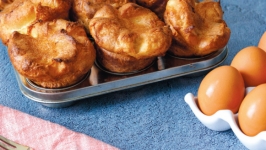On the Rise
“I love a Yorkshire pudding. It's basically pancake batter that's fried in beef fat and puffs up; it's like you can't go wrong.”
—Samin Nosrat
Yorkshire puddings—or “Yorkies.” for those in the know—were created during the 16<sup>th</sup> century by cooks in the north of England who wanted to make use of the fat that collected in the dripping pan while their meat roasted. In poorer households, it would also be eaten as a first course with a simple gravy to fill up the stomach, thus allowing the meat to go further. Contrary to the name pudding, the Yorkie is a savory delight and is typically served alongside roasted beef, steamed vegetables, and crisp roasted potatoes smothered with gravy.
The humble Yorkshire pudding may look like the American popover, but they’re not the same thing. Where popovers have glossy tops, Yorkshire puddings have a hole-like cavity in the middle—perfect for pouring gravy into. They’re also easier to make—just a simple batter of flour, eggs, and milk roasted in a hot oven, while popovers contain the richer addition of melted butter.
The Yorkshire pudding can be made in a rectangular tin and cut into squares to be served with a traditional British roast Sunday dinner. It can also be made with whole sausages cooked within it, a dish known as toad-in-the-hole. It is commonly made in a muffin pan (my preferred method). The perfect Yorkshire pudding mixture needs to be light and airy, with the fat in the bottom of the cooking dish needing to be as hot as possible in order for it to rise.
Yorkies freeze beautifully and I usually bake up a few trays which I can then freeze. Reheating is as simple as popping the desired number of Yorkies into a hot oven for a few minutes until crisp—never microwave!
During my quest to find the perfect Yorkshire pudding recipe, I sampled at least four recipes from famous British chefs who have been producing and testing these recipes for many years. In the end, the best Yorkie was produced by the use of an additional egg, a combination of milk and water, and a searing hot oven, and resisting the urge to open the oven door while they are cooking!
Here’s my recipe, which is an adaptation from one published by Mary Berry—some of you may recognize her name from her appearance on “The Great British Bake Off.”






